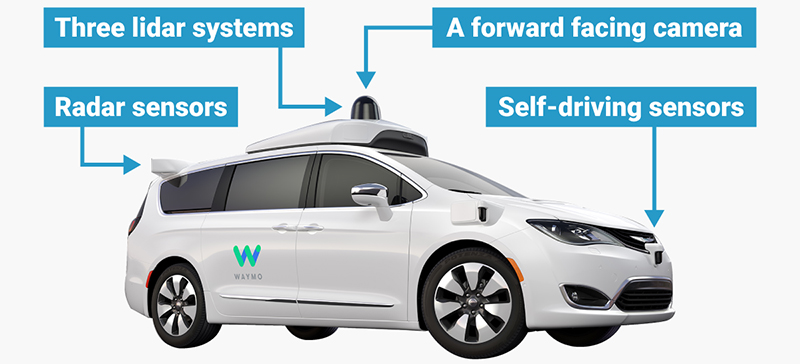The promise of the Jetsons has finally arrived as autonomous vehicles of all types come at us. Or is that promise really here quite yet?
Leading the pack are commercial airliners that typically rely on autonomous control more than they do on pilots and co-pilots. Built as a completely autonomous cargo ship, the Norwegian Yara Birkeland is to set sail next year followed by Rolls-Royce's autonomous tug boats and ferries in 2020. And, of course, there are autonomous drones, especially in military operations, that will one day make human-controlled drones a quaint memory.
Clearly, the subject of autonomous vehicles is far too broad for this edition of NextGen Supply Chain. So this month we'll focus on autonomous vehicles for roadways.
There's no question that autonomous vehicles (although not flying ones a la the Jetsons) are rapidly motoring toward our roadways. After all, the big money chasing them extends from Apple and Google to General Motors and Otto, to name just a few of the many. It's entirely possible that autonomous vehicles are the best funded R&D project in the history of mankind.
“Autonomous vehicles are a competition, a race. The quickest and best companies at it will make billions if not trillions from the technology,” says Kevin Lacy, director of the transportation, mobility and safety division for the North Carolina Department of Transportation. See “The Interview” in this edition of NextGen Supply Chain for Lacy's state-level view of autonomous vehicles.
Part of the shakeout here is what companies will do what in this space. Does Apple really want or need to supply autonomous vehicles, for instance?
As Stefan Heck, founder and CEO of Nauto has pointed out, existing vehicle manufacturers are better at building cars than his company ever will be. So he will just stick with developing the intelligence for autonomous vehicles.
Waymo, the self-driving unit of Google's parent Alphabet, had a similar revelation this summer. That's when it announced a pivot from developing its own self-driving cars to developing self-driving technology for cars mass produced by others. That resulted in the demise of the company's Firefly self-driving car (no steering wheel, no peddles) - probably the first retirement from the autonomous vehicle race.

In other words, we have to be aware of the difference between possibility and probability and pervasive. That's true for individual suppliers in particular as well as autonomous vehicles in general. As to the latter, we are right now most likely in the early days of stage two of that sequence.
Fact is, making cars and trucks completely autonomous is a complicated undertaking. Just ask the professional society of automotive engineers, SAE International. It has identified six distinct levels of autonomous operation.
The six are:
- No automation
- Driver assistance
- Partial automation
- Conditional automation
- High automation
- Full automation.
As you can see, only at the top level is the vehicle completely autonomous.
How quickly we get to that top level is anybody's guess. And the timelines vary greatly depending on the source.
The CEO of Nvidia, a supplier of chips for autonomous vehicles, said late last month, “it will take no more than four years to have fully autonomous cars on the road. How long it takes for the vast majority of cars on the road to become that, it really just depends.”
Pew Research released a survey in early October on Americans' attitudes toward driverless vehicles. A majority (56%) expect fully autonomous vehicles to be on our roads in 10 to 49 years. Only 9% say it will happen in less than 10 years. Another 8% says autonomous vehicles will never happen.
Getting there will be a wild ride. But the potential benefits of the technology are enormous.
To begin, Lacy and many other experts see autonomous vehicles as the most likely path to reducing highway deaths. That's no small consideration with nearly 37,500 highway deaths last year alone. Quite simply, the artificial intelligence software onboard autonomous vehicles identifies more obstacles than humans and identifies them all earlier, reducing reaction time to just a fraction of what people require.
As a result, autonomous vehicles can also drive closer together both laterally and in-line, allowing greater traffic density and increasing the capacity of roadways. Furthermore, they can do this at higher speeds than human-driven vehicles.
A just released computer simulation of how Boston's downtown traffic would change had other benefits, say sponsors Boston Consulting Group and the World Economic Forum. They anticipate that autonomous vehicles, combined with new ride sharing initiatives, would reduce the number of cars on the road, allow them to drive greater distances, reduce traffic time, create steadier speeds and make braking more gradual.
The next higher-level scenario is to interconnect individual vehicles across a mobile network on roadways. The network allows vehicles to communicate with each other and anticipate movements and obstacles before they became an issue. Beyond that, the network would re-route vehicles based on highway usage, a future eye in the sky. The days of helicoptered and on-ground traffic reporters and reports would be gone.
But we aren't there yet. Not even close on the network part.
For all the hype we are now at the testing stage to make the possibility of autonomous vehicles a probability as we move along the road to pervasive use.
For instance, Waymo, the self-driving unit of Google's parent Alphabet, launched last month the first fleet of fully driverless vehicles. They will be tested in the Phoenix area. Waymo employees will be in the vehicle, but sitting in the back seat.
That milestone is made possible by two key factors. To begin, Waymo is in a position to do it in the first place. But just as important, it is happening in Phoenix because local laws allow it.
Both local initiatives and federal efforts are part of the equation. The U.S. Department of Transportation has designed ten sites as testing grounds. Modifications of federal regulations also figure in the equation.
So it's time to pay attention more closely than ever as we move along the road to autonomous vehicles. Milestones will come. And milestones will go. Rest assured that this is a continuing story sure to affect all of our supply chains, not to mention our lives. And there's no hype whatsoever in that statement.
Gary Forger is contributing editor of NextGen Supply Chain. He can be reached at [email protected].
SC
MR


Latest Supply Chain News
- Humanoid robots’ place in an intralogistics smart robot strategy
- Tips for CIOs to overcome technology talent acquisition troubles
- There is still work to do to achieve supply chain stability
- Blooming success: The vital role of S&OE in nurturing global supply chains
- Supply chain salaries, job satisfaction on the rise
- More News
Latest Resources

 Explore
Explore
Software & Technology News
- Humanoid robots’ place in an intralogistics smart robot strategy
- Tips for CIOs to overcome technology talent acquisition troubles
- Game on: Rethinking change management for the digital era
- Predicting stockouts: Enhancing FMCG resilience through data-driven insights
- Top Performers Investing in, Benefitting from AI
- Electronics Supply Chain Seeks Balance in 2024
- More Software & Technology
Latest Software & Technology Resources

Subscribe

Supply Chain Management Review delivers the best industry content.

Editors’ Picks





